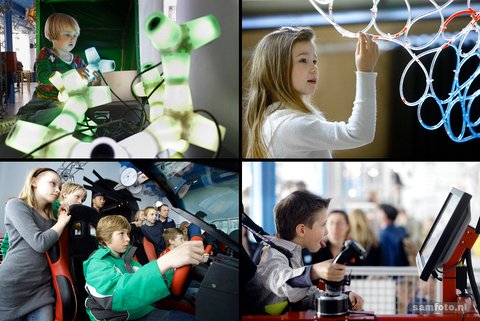Techniek niet meer aantrekkelijk onder de jeugd? Je zou het niet zeggen als je afgelopen zondagmiddag in het Science Centre Delft was. Het was een topdag met veel bezoekers, die in het kader van het Nationaal Museumweekend voor één euro naar binnen mochten.
Het was voor ruim een miljoen mensen reden dit weekend naar een van de ruim vierhonderd deelnemende musea te gaan.
After ten years of relative quiet, interest in space tethers is picking up, Michiel Kruiff (MSc), of Estec in Noordwijk, observes. He graduated on the subject of space tethers from TU Delft’s faculty of Aerospace Engineering. Together with Delta-Utec’s Erik van der Heide, Kruijff proposed a space tether mission to the European Space Agency (ESA), and then got lucky when the first Ariane V rocket exploded (4 June 1996). ESA decided to fire another Ariane without a payload, as a means of restoring confidence in the launcher, which provided Kruijff and colleagues with an opportunity for a free ride into space.
The mission, called Young Engineer’s Satellite (Yes), consisted of a 35 km Dyneema rope attached to a 12.5 kilogram mass. Once in orbit the mass would be ejected, pulling the rope behind it into space. Once the height difference becomes more than 500 metres, the gravity gradient is large enough to start pulling out the rope by the weight of the mass.
Lucky as they were with the free launch, so unfortunate was the timing. Kruijff explains that if the satellite had been launched in the afternoon, sunlight would have pushed the rope – after it had been cut – towards the
atmosphere, where it would simply burn up at re-entry. But since the launch on 30 October 1997 took place in the morning, the Yes satellite ended up on the wrong side of the globe and ESA would not permit deployment for fear that the rope would float around indefinitely. Eventually Kruijff decided to first cut the rope and then eject the mass.
Ten years later, Kruijff got a second chance with the Yes2 mission, which was launched on 14 September 2007. This time the 8 kilogram ejection mass contained a 6 kilogram capsule, called Fotino, which was to return to Earth as a demo for Space Mail. Despite some hiccups the mission was largely successful and won Kruijff an entry in the Guinness Book of Records for having realised the tallest structure (32 km) in space.
The most useful applications of space tethers might be as conducting ribbons, which experience a Lorentz force in the Earth’s magnetic field and can thus pull floating space debris down to the atmosphere. Kruijff: “Within a couple of years, 98 percent of the space junk can be eliminated.
”Michiel Kruijff: ‘Tethers in Space, A Propellantless Propulsion In-Orbit Demonstration’, 30 May 2011, PhD supervisors: Prof. Wubbo Ockels and Prof. Eberhard Gill.



Comments are closed.